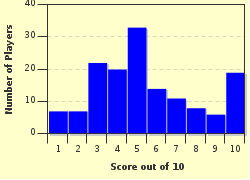Quiz Answer Key and Fun Facts
1. Bara is the Welsh word for bread. Which of these is not actually bread?
2. Perhaps the most famous item of Welsh cuisine is Welsh rarebit, which is much more than just cheese on toast! What's it called in Welsh?
3. Teisennau lap were a big favourite at our house. It was a family tradition to serve them on Sunday at teatime. If I tell you that teisen means cake (teisennau is cakes) and lap means plate, and that they are almost as well-known internationally as Welsh rarebit, can you tell me their name in English?
4. The national dish of Wales is roast lamb, and at our house it's served with green peas, new potatoes, mint sauce and lashings of gravy. It's what we have for dinner on St. David's Day (March 1) and Easter Day. Now if I tell you that cig is Welsh for meat and rhost is Welsh for roast, how does one say roast lamb meat?
5. On New Year's morning, children go from door to door collecting calennig (the New Year's gift). When I was a child, we used to carry oranges decorated with cloves, with a handle made of a corn stalk. The local historian told us the oranges were a holdover from the Roman custom of strena, a way of ensuring good crops in the coming year. Be that as it may, in exchange for wishing the householders "Blwyddyn Newydd Dda" (Happy New Year), we received small change (ha'pennies and pennies usually, threepenny bits if we were lucky!) and a Welsh cake or a bit of cyflaith triog. If I tell you that triog is Welsh for treacle, can you tell me what cyflaith is?
6. This recipe for a traditional Welsh drink comes from the household journal of my 5 x great-grandmother Myffanwy Edwards. The journal is dated 1768. My mother, who was a professional cook, translated the recipe into modern ingredients and terms (Myffanwy's recipe requires heather which is hard to come by in North America!) The Welsh call this metheglin. What is it in English?
7. My husband, who was a vegetarian, enjoyed this traditional Welsh dish which goes by the name of selsig sir Forgannwg. Selsig means sausage, Forgannwg is the Welsh word for the region known as Glamorgan in South Wales, so what do you suppose 'sir' means?
8. The Welsh, the Cornish and the Bretons share a common Celtic heritage and while there are subtle differences in language and pronunciation, they can make themselves understood to one another using their own languages. When World War II ended, Wales once again saw Bretons cycling along our roads, selling strings of a specific vegetable. In Welsh it's called nionyn or nionod. What is it in English?
9. One of my favourite desserts is pwdin reis. If I tell you that pwdin is Welsh for pudding, can you tell me what reis means?
10. No quiz about Welsh cuisine would be complete without a dish made from this ancient national symbol. Which one?
Source: Author
Cymruambyth
This quiz was reviewed by FunTrivia editor
ozzz2002 before going online.
Any errors found in FunTrivia content are routinely corrected through our feedback system.

